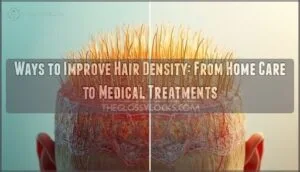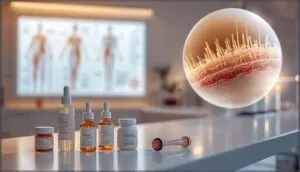This site is supported by our readers. We may earn a commission, at no cost to you, if you purchase through links.

Your hair follicles don’t vanish when your hair thins—they shrink. Androgenetic alopecia, the most common form of hair loss, doesn’t destroy follicles but miniaturizes them until they produce strands so fine they’re barely visible.
This process affects 80% of men and nearly 50% of women by age 50, yet most people don’t realize their follicles remain salvageable. The key to reversing thinning hair lies in understanding what triggers this miniaturization, from hormonal shifts and nutrient deficiencies to daily grooming habits that quietly damage your scalp.
Whether you’re noticing wider parts, a receding hairline, or simply less volume than you had a year ago, evidence-based strategies can reactivate dormant follicles and rebuild density—but the approach depends on identifying your specific triggers first.
Table Of Contents
Key Takeaways
- Hair follicles don’t vanish during thinning—they shrink through a process called miniaturization, meaning they remain salvageable with the right interventions targeting DHT sensitivity, nutrient deficiencies, or grooming habits.
- Medical treatments like minoxidil (5% formulations show ~15 hairs/cm² gains) and finasteride (8% density increase) offer proven results within months, while PRP therapy and low-level laser therapy provide non-invasive alternatives with strong safety profiles.
- Daily scalp care—including 4-minute massages that boost circulation by 400%, gentle cleansing to preserve oil balance, and protective drying methods—creates a healthier follicle environment without requiring prescriptions.
- Nutrition and lifestyle factors (adequate protein, iron, omega-3s, stress management, and 7-9 hours of sleep) work synergistically with treatments, as deficiencies in vitamin D, biotin, or zinc directly impair follicle function and hair shaft formation.
Common Causes of Reduced Hair Density
Hair density doesn’t just thin overnight—it’s usually a mix of factors working quietly in the background. Genetics, hormones, daily habits, and even your health can all play a role in what’s happening at your scalp.
Let’s break down the most common culprits so you can identify what might be affecting your hair.
Genetic and Hormonal Factors
When hair starts thinning, genetic predispositions and hormonal imbalances often hold the answer. Androgenetic alopecia, the most common form of hair loss in both men and women, occurs when your hair follicles develop DHT sensitivity. This leads to follicle miniaturization, where strands gradually shrink with each hair cycle.
Key genetic and hormonal factors include:
- Up to 80% of androgenetic alopecia cases stem from hair loss and genetics you inherit from family members
- DHT, a testosterone derivative, shortens your growth phase and causes hair loss in men through receding hairlines
- Hair loss in women usually appears as diffuse thinning across the scalp due to hormone changes
- Pregnancy, menopause, and thyroid conditions alter follicle activity through hormonal fluctuations
- Chronic stress elevates cortisol, disrupting your natural hair cycle and accelerating shedding
Elevated DHT levels can lead to hair follicle miniaturization, a key factor in hair thinning.
Medical Conditions and Medications
Beyond genes and hormones, underlying illnesses and prescription meds can greatly disrupt your hair growth cycle. Autoimmune alopecia affects roughly 2% of people worldwide, while thyroid disorders cause brittle, slow-growing strands in up to 28% of hair loss patients. Chemotherapy effects are particularly striking, with hair loss occurring in 99.9% of patients. Lupus can also lead to hair thinning or complete balding.
Medical treatments for hair loss and medical conditions often overlap:
| Condition | Hair Impact |
|---|---|
| Iron deficiency anemia | Disrupts oxygen to follicles, impairing hair density |
| Thyroid disorders | Causes diffuse thinning, coarse texture |
| Medication-induced loss | Antidepressants, blood thinners trigger shedding |
Understanding these prescription meds and health factors helps you address hair loss treatment more effectively.
Hairstyling and Grooming Practices
While health issues and medications certainly matter, your daily hair care techniques also shape follicle health. Tight hairstyles like ponytails or braids create traction alopecia through constant pulling.
Heat styling and chemical treatments weaken keratin bonds, increasing hair breakage by up to 88.5%. Even seemingly harmless grooming, such as wet combing, causes microscopic changes that precede visible hair damage.
Effective Medical Treatments for Hair Density
When home remedies and lifestyle changes aren’t enough, medical treatments offer proven ways to restore hair density. These approaches range from topical solutions you can apply daily to sophisticated in-office procedures that target hair follicles directly.
Let’s look at the most effective medical options backed by clinical evidence.
Minoxidil and Topical Solutions
Regarding proven topical treatments for hair regrowth, minoxidil stands out with solid clinical backing. Studies show that 5% formulations improve hair density in about three-quarters of users, with gains averaging nearly 15 hairs per square centimeter.
You’ll likely see results within months, though individual responses vary based on genetics and baseline severity. Most people tolerate it well, experiencing only mild scalp irritation.
Prescription Medications (e.g., Finasteride)
For oral medications targeting hair loss, finasteride efficacy stands out among prescription meds. Clinical trials reveal that daily 1 mg doses increase hair count by roughly 8%, with treatment costs remaining affordable through generic versions.
Most users tolerate these hair loss medications well, though about 2-4% experience sexual side effects. Following dosage guidelines closely ensures best outcomes, and results usually appear within several months.
Platelet-Rich Plasma (PRP) Therapy
PRP efficacy relies on your body’s own platelets to boost hair regrowth. This platelet-rich plasma therapy usually requires three to six treatment sessions spaced a month apart, with maintenance every six to twelve months.
Its safety profile remains strong since it uses your blood, and biological effects include growth factors that stimulate follicles.
Cost analysis reveals sessions ranging from four hundred to fifteen hundred dollars each.
Low-Level Laser Therapy (LLLT)
Unlike medications you swallow or injections, low-level laser therapy uses cool beam lasers to stimulate your follicles safely. Clinical trials show LLLT increases hair density with a standardized mean difference of 1.27 compared to inactive devices.
- FDA-cleared devices include combs, helmets, and caps you can use at home
- Treatment requires multiple sessions weekly for at least sixteen weeks
- Studies report 83% patient satisfaction with visible improvements
- No burning risk or significant side effects documented
Home Remedies and Scalp Care Tips
Not every solution for thinning hair requires a prescription or a trip to the clinic. Your daily hair care routine can make a real difference in how your scalp functions and how strong your strands become over time.
Here are a few practical, at-home strategies that can support healthier, denser hair.
Nourishing Oils and Natural Masks
Natural oils like coconut, castor, and rosemary can improve hair density by improving oil penetration and scalp circulation. Some oils even offer DHT blocking properties, which may help reduce thinning.
These essential oils, along with mask ingredients such as avocado and egg, provide nutrients that strengthen hair follicles and support hair growth.
A weekly regimen of oil treatments and natural hair remedies promotes healthier scalp health and thicker hair over time.
Gentle Cleansing and Conditioning
You can’t build density on a weak foundation, and your scalp is that foundation. Harsh cleansers strip away scalp oil balance, leaving hair brittle and prone to breakage, while thoughtful wash frequency and proper conditioner application protect what you’re working to grow.
- Gentle shampoos preserve moisture, reducing frizz and breakage that visually thin your hair
- Washing 5–6 times weekly with the right products promotes overall hair health and scalp comfort
- Conditioning agents lower combing forces, preventing mechanical damage during styling
- Buildup removal creates a cleaner environment for follicles, improving nutrient delivery
- Moisture retention keeps cuticles smooth, enhancing hair manageability and resilience against environmental stress
Scalp Massage Techniques
Your fingertips can be powerful tools for hair growth stimulation. A 2016 study demonstrated that a daily 4-minute scalp massage increased hair thickness from 0.085 mm to 0.092 mm over 24 weeks. Gentle, circular motions with moderate pressure applied across the entire scalp can boost circulation by up to 400%, delivering oxygen and nutrients to follicles while reducing cortisol levels linked to hair loss.
A daily four-minute scalp massage can boost circulation by up to 400%, delivering nutrients to follicles and measurably thickening hair over time
The circulation boost from consistent scalp treatments creates a healthier environment for hair, potentially extending the anagen growth phase. Additionally, mechanical stress from massage alters gene expression in dermal papilla cells, upregulating hair cycle-related genes.
| Massage Frequency | Technique Variations | Oil Benefits |
|---|---|---|
| 5–10 minutes daily or 4–5 times weekly | Circular fingertip motions with moderate pressure | Coconut, argan, and castor oils moisturize and strengthen follicles |
| Twice-daily sessions stabilize thinning | Cover entire scalp systematically | Coconut, argan, and castor oils moisturize and strengthen follicles |
| Minimum 3–4 months for visible results | Avoid overly vigorous pressure | Help remove product buildup |
| Consistency matters more than duration | Gentle handling prevents irritation | Support nutrient delivery to scalp tissues |
Protective Hair Drying Methods
Beyond massage, how you dry your hair matters greatly for hair density. Vigorous towel drying raises cuticles and causes friction damage, while microfiber towels gently blot excess moisture.
Air drying after blotting preserves hair health, though prolonged wetness can weaken strands.
When heat styling is necessary, apply heat protectants, use low heat settings, keep your dryer moving, and detangle damp hair with a wide-tooth comb to minimize breakage.
Nutrition and Lifestyle for Thicker Hair
What you eat and how you live can influence your hair’s thickness more than you might expect. Your body needs specific nutrients to build strong hair shafts, and certain habits can either support or undermine that process.
Let’s look at the dietary choices, stress patterns, and daily routines that research links to healthier, denser hair growth.
Key Vitamins and Minerals for Hair Growth
Among the micronutrients that keep hair thriving, vitamin D, biotin, iron, zinc, and selenium stand out for their roles in follicle health and density. Biotin deficiency can lead to thinning, while vitamin D stimulates new follicle formation. Zinc benefits include supporting protein synthesis, and vitamin C enhances iron absorption, ensuring oxygen reaches your scalp.
Hair growth supplements addressing these nutritional deficiencies often combine these elements to support thicker, stronger strands.
Diet Adjustments to Prevent Hair Loss
If you’re aiming for thicker hair, start with your plate. Protein intake, iron sources like leafy greens, and omega-3s from fish or nuts help guard against nutritional deficiencies and hair loss. Cut back on sugar—high intake is linked to thinning.
Nutrition and hair growth go hand-in-hand, so watch for vitamin deficiencies and avoid nutritional imbalances for lasting scalp health.
Stress Management Strategies
If you’ve already cleaned up your diet, don’t overlook stress management—your scalp feels every worry. High stress boosts cortisol, which disrupts hair growth and density. Try these comprehensive approaches for hair loss prevention:
- Practice relaxation techniques like deep breathing and yoga
- Explore therapy options for support
- Make lifestyle changes to reduce cortisol and protect your hair
Importance of Adequate Sleep and Hydration
Restoration begins at night—deep sleep triggers Sleep-Hair Hormones that fuel Follicle Regeneration and support hair health. If you’re skimping on sleep, you risk hair loss from shortened growth cycles.
Hydration Effects matter, too; two liters daily keep your scalp balanced and hair strong.
Consistent Sleep Recommendations and mindful water intake work together, bolstering Density Mechanisms for real hair loss prevention.
Advanced Therapies and Maintenance Strategies
If you’re looking for more sophisticated ways to boost hair density, there are several promising options worth considering. These approaches go beyond basic care and nutrition, focusing on long-term results.
Let’s take a closer look at what’s available and how each strategy can help you maintain thicker hair.
Emerging Growth Factor and Stem Cell Treatments
Could a drop of innovation truly change your hair’s future? Sophisticated in-clinic therapies now employ hair growth factors and stem cell techniques, stimulating hair follicles for denser, healthier strands. Clinical efficacy looks promising, with safety profiles showing mild side effects.
Novel approaches like exosome-based systems and individualized treatments are reshaping hair loss treatment options, while future research continues to expand hair loss research horizons.
Hair Transplant Options
A hair transplant surgery offers you one of the most reliable hair loss solutions, with FUE advantages like minimal scarring and natural results, while FUT drawbacks include more visible scars but slightly higher graft survival.
Cost analysis shows wide variation—Turkey’s lower prices versus the U.S.
Patient demographics skew toward adults in their late thirties, reflecting evolving hair regrowth options among medical hair loss treatments.
Maintaining Results and Preventing Relapse
Think of hair maintenance like tending a garden—consistent care matters. Treatment adherence, from minoxidil to PRP, helps you hold onto gains.
Lifestyle changes, such as stress reduction and quitting smoking, support hair loss prevention strategies.
Nutritional support, medical monitoring, and emotional support form the backbone of your hair care routine, making relapse less likely and keeping hair growth strategies on track.
Setting Realistic Expectations for Hair Density
You won’t see overnight transformations, and that’s important to understand. Treatment timelines generally demand three to six months before measurable hair density changes appear, while genetic limitations mean you may not fully restore your original thickness.
Psychological impact from unmet expectations can be significant, so use density assessment tools like photos and ponytail measurements to track progress.
Transplant viability depends on scalp health, and setting realistic goals keeps hair growth strategies grounded in what’s actually achievable.
Frequently Asked Questions (FAQs)
Can certain hairstyles promote better hair density?
Yes, your styling choices directly affect hair density. Protective styles like loose braids reduce hair breakage and scalp stress, while tight ponytails risk follicle miniaturization. Gentle styling preserves hair appearance and minimizes tension hairstyle risks.
How does scalp health affect hair thickness?
Your scalp isn’t just skin—it’s the soil your hair grows from. Scalp inflammation, poor blood circulation, sebum imbalances, microbiome disruption, and buildup all choke follicles, thinning strands and reducing density noticeably.
Are there specific exercises that boost hair growth?
Regular cardio for hair growth stimulation works by enhancing scalp circulation, delivering oxygen and nutrients to hair follicles.
Yoga benefits include stress reduction and follicle stimulation, while scalp massage techniques improve exercise intensity effects.
Do environmental factors contribute to hair thinning?
Pollution exposure, UV radiation, smoking effects, and chemical toxins all accelerate hair thinning through oxidative stress and follicle damage.
Stress synergy with environmental factors worsens hair loss causes, making diagnosis and treatment essential.
What role does gut health play in hair density?
Your gut microbiome influences hair density through nutrient absorption, hormone regulation, and inflammation control. Gut inflammation and leaky gut disrupt microbiome balance, reducing hair growth.
Probiotic benefits include improved hair health and enhanced follicle nutrition.
Conclusion
Like a garden left untended, your scalp won’t restore itself through wishful thinking alone. The ways to improve hair density you’ve explored—from minoxidil’s proven track record to scalp massages and nutrient-rich meals—work best when combined strategically.
Your follicles haven’t disappeared; they’re waiting for the right intervention. Start with one evidence-backed approach, monitor your progress over three months, and adjust accordingly. Consistency, not flawlessness, rebuilds what time has thinned.










